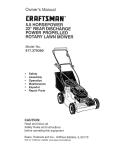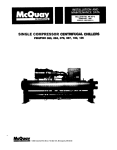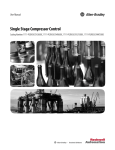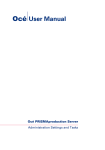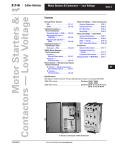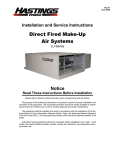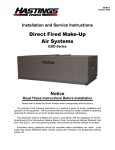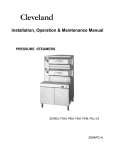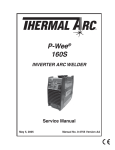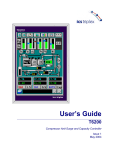Download IM PE-G063: Top Mounted Compresor Units PE
Transcript
049 March, 1981 Supersedes PE-G2 Dated Dec., 7975 PE-G3 Dated Oct., 1976 Westinghouse Electric Corporation OPERATION MANUAL Commercial-Industrial Air Conditioning Division Staunton, Virginia 24401 PE - 606310791160 Models PE 15OW 55OW PE 063/079/100 Top Mounted Compressor Units Only Operation & Maintenance Manual - COMPRESSOR NAMEPLATE MAIN UNIT NAMEPLATE AND SHOP ORDER NO CONDENSER NAMEPLATE EVAPORATOR NAMEPLATE OPERATION APPLICATION Recycling Timer (TDR) -Set 40 minutes. Limits number of starts per hour (3 starts in 2 hours). The operation and maintenance procedures covered in this publication apply to model PE (hermetic motor) and PG (open motor drive) units of the compressor sizes indicated throughout the literature. Open drive units require additional operation and maintenance inspections related to motor bearing lubrication coupling and shaft alignment. For coupling and shaft alignment, see Bulletin PE-G10. For motor maintenance, see the instructions for service provided by the motor manufacturer. I. Cycling Thermostat-C.T. W ill stop machine when the leaving water reaches its set point in normal operation. Vane Closed Switch-V.C. Prevents the machine from starting if the vanes are not closed. CONTROL CENTER The control center is wired so that an indicating light will be energized upon the action of any of the safety controls. The light will remain on until such a time as the control circuit is reset even though the cause of compressor shutdown has been corrected or has corrected itself. Repeated trippings of any safety control should be investigated by a qualified refrigeration mechanic or Westinghouse service engineer. The control reset buttons are located on the outside of the control center. Discharge, suction and oil pressure gauges are provided on the control center. The control center contains all of the necessary protective and operating controls, (less water flow interlocks). These include the cycling thermostat, the Guardistor protective circuit,SurgegardTM, high and low pressure cutouts, oil pressure protector, oil temperature cutout, vane closed switch, low pressure override, oil pump time delay, oil pump contactor, oil pump overload, capacitor, recycling timer, indicator lights and relays, motor load and temperature module. The current design control center is subject to redesign and modification. If the unit control center is different than the one shown in Figure 2, see PE-G063/079/100 supplement. An interior view of the control center is shown in Fig. 2. B. Guardistor Protective Circuit A. Controls Positive protection against motor overheating is provided with this unique Westinghouse motor development. The heart of the Guardistor protective circuit are the thermistors, embedded in the motor windings, which sense motor temperature. (For complete control summary, see Table 1.) The function of operating controls is as follows: Oil Pump Time Delay (OTD) -Set at 30 seconds to keep oil pump running for 30 seconds after machine has shut down. When the motor temperatures are normal, the therm- TABLE 1 - OPERATING CONTROL SUMMARY CONTROL SETTING SYMBOL HIGH PRESSURE CUTOUT* LOW PRESSURE CUTOUT* 150 PSIG 26 PSIG H. P. L. P. Stop machine on excessive head pressure Stop machine on excessive drop in suction pressure. FUNCTION 0. D. Stop machine when oil pressure differential drops to 50 PSIG. OIL PRESSURE SWITCH* 50 PSIG LOW PRESSURE OVERRIDE 28-31 PSIG OIL TEMPERATURE SWITCH” 14O’=F 0. T. Stop machine when oil temperature entering machine exceeds setting. 23O’=F 30 PSIG H. T. v. c. Stop machine on rise in discharge temperature Will not allow machine to start if the vanes are not closed to minimum DISCHARGE TEMPERATURE VANE CLOSED SWITCH SWITCH* L. P. 0. Closes vanes, on drop in suction pressure OIL PUMP TIMER 3 Minutes 0. P. T. RECYCLING TIMER 40 Minutes T. D. R. Limits number of starts of machine to 3 every 2 hours. OIL PUMP TIME DELAY 30 Seconds 0. T. D. Keeps oil pump running for set time after machine stops CYCLING THERMOSTAT Adjustable 3 6 F 9OF C. T. LOW OIL TEMPERATURE* 120° (Min.1 L. 0. T. SYSTEM MONITOR TIMER 1 Minute SURGEGARD RELAY” _ Stops oil pump if machine fails to start. Stop machine when chiller leaving water reaches temperature below design condition Prevents compressor from starting with low oil temperature S.M. Lights system monitor light if machine does not start due to external interlocks or starter safeties. S.G.R. Lights Surgegard light and shuts down machine if surge condition developes-check condenser water and tower condition. *All safety switches that stop the machine require manual resetting before machine will restart 3 Figure 2 P P VANE SPEED ADJUSTMEN rOPEN J 1.. Relay Base 2. 3. 4. 5. 6. 7. 8. 9. 10. 11. O.P.T. Relay Oil Pump Run Capacitor Oil Pump Contactor Transformer Oil Pump Time Delay (OTD) Anti Recycle Timer (TDR) Relay115Volts(R1 thruR7) Guardistor Relay Solid State Module Low Oil Temperature Cutout istor has low resistance which remains nearly constant up to predetermined critical temperature. At this temperature, a sharp increase in resistance occurs for a small increase in temperature. This sharp increase in resistance causes the Guardistor relay to drop out which in turn interrups the flow of current to the Guardistor reset relay causing it to become deenergized. When the Guardistor reset relay contacts open, t h e M C R r e l a y h o l d i n g c o i l b e c o m e s deenergized stopping the compressor. A thermistor-equipped motor which utilizes the Guardistor protective circuit integrates all heat causing factors of load, ambient, and power supply in the motor windings to give you greatly increased protection against motor burnout. The Guardistor control is a manual reset protective 12. 13. 14. 15. 16. 17. 18. 19. 20. 21. 22. CL )SE Oil Pressure Gauge Discharge Pressure Gauge Evaporator Pressure Gauge Oil Pump Motor Overload High Pressure Switch Cycling Thermostat Low Pressure Override Surgegard Relay High Oil Temperature Thermostat Low Pressure Switch System Monitor Timer device. The reset button is provided on the control center. THE CONTROL CIRCUIT MUST BE RESET IN THE EVENT OF A POWER FAILURE OR WHENEVER THE CONTROL VOLTAGE SOURCE IS INTERRUPTED. C. SurgegardTM Westinghouse currently uses a control device to sense the occurance of a surge and stop the compressor before any damage can be sustained. The Surgegard relay will prevent the compressor from restarting automatically until the malfunction can be corrected. Possible causes for a surge, or rotating stall condition, may be dirty condenser tubes, cooling tower, pump, or control malfunction which acts to elevate the system’s head. D. Solid State Capacity Control Figure 3 The Westinghouse solid state capacity control is designed to provide the temperature control and current limit control in a single solid state package with a proportional type pulsing temperature control action. The control is provided with indicator lights and a quick disconnecting cable for replacement of the entire module in case of malfunction of its internal circuits. When the automatic temperature control is in operation, the vane control solenoids are energized intermittently at a frequency which increases in intensity as the water temperature departs from the set point until a full signal is maintained when the water temperature is approximately 6OF or more away from the required temperature. This action is designed to eliminate the saw tooth operation of the conventional floating control and should provide extremely stable temperature control when coupled with the needle valve vane speed controls. The speed of the vane close operation is approximately one minute from full open to full close, and 3 to 5 minutes from full closed to full open. A selector switch provides the operator with means for manual control in addition to the normal automatic operation. Switch positions are: Stop - this places the vanes in a stop position. Load - this energizes the load solenoid, moving the vanes to an open position. Unload - this energizes the unload solenoid, moving the vanes to a close position. Automatic - this provides for automatic operation as described above. sketch Fig. 3. 2. Metering Valves The needle metering valves in the oil drain lines are used to control the speed of vane travel while under temperature control. The valves are factory-set so that from a full close to full open position of the vanes requires a minimum of 3 minutes. Maximum rate of travel will be dictated by load requirements. To decrease speed of travel, close the valve slightly. Speed should be slow enough to prevent overcontrolling. At this rate of travel, the temperature can be sensed and vanes stopped before a hunting situation occurs. Vane speed can be adjusted through access holes on the right hand side of the control panel. Indicator lights will function as follows: Red will light during the unloading control action; green will light during loading, and amber will light when the load action is overridden by the current limit control. This light will not light if the current limit acts while the capacity control is in hold or unloading position. Current limit will override manual control. 1. Vane Operation The hydraulic system for the vane control operation consists of a 4-way normally-open solenoid valve. The action of this solenoid valve controls the operation and position of the vanes. Oil under pressure is supplied to either or both sides of the piston depending upon what signal is being given by the electronic control. E. Temperature Control The temperature control has been calibrated at the factory and should not need adjustment. Run the unit for several hours and check the leaving water temperature against customer requirements. If calibration is required, operate the system by hand and obtain the proper condition. To open vanes, solenoid “SA” is de-energized and “SB” is energized allowing oil to flow from port C2 in the solenoid valve to the piston and from the piston to the drain through port Cl. Because of the proportioning features of the temperature control, it will be necessary to have the selector switch in the hold position for at least 5 minutes before calibration. (The thermal feedback action will cause an apparent and temporary shift in set point in the direction of the applied feedback or control action. ) To close vanes, “SB” is de-energized and “SA” is energized allowing the oil to flow from port Cl to the piston and draining from port C2. When the vanes are in hold position, both solenoid coils are de-energized putting full oil pressure on both sides of the piston through both Cl and C2 ports. See 5 3. Set the temperature selector knob at the actual leaving water temperature. Switch the control to automatic and immediately calibrate the temperature control until both lights are out. One or the other of the lights will eventually begin to pulse because the dead band is less than .5F. However, the lights should never alternately pulse between load and unload unless the vanes are moving too fast. leaving oil temperatures should be on the low side of the acceptable temperature range when operating with the coldest water. Long shutdown periods will produce higher than normal chilled water temperatures at startup and will result in higher oil temperatures until the chilled water temperature is reduced. Bearings are supplied with oil through internally drilled passages. The oil drains from the bearings into the gear housing and returns to the oil pump through the scavenger line. F. Current Limit The oil pump also supplies the oil to the hydraulic piston for positive positioning of the inlet guide vanes. Proper operation of the hydraulic system and bearing lube system can be maintained only if Westinghouse recommended oil is used. Westinghouse recommended oils are 300 sus. viscosity (Suniso 4G or Texaco WF68) for PE063 and PE079, and 500 sus. eviscosity (Suniso 5G or Texaco WFIOO) for the PEIOO. 1. A 5.0 volt signal is required from the compressor starter current transformer at full current. A 1 ohm resistance will provide 5.0 volts from a 5 amp transformer setting. 2. Set the current demand limit selector switch against the stop 100% and the current limit calibration screw fully counter-clockwise, 3. Start the system and place the selector switch in load position. When the full load current reaches customer requirements, turn the current limit calibration clockwise until the amber light comes on. This places the control in current limit hold position and insures that the unload action will be energized if the current increases an additional 5%. Unload the machine and reload to R.L.A. (Rated Load Amperage) and check calibration. a II. The quantity of oil charge for each machine is shown in the Physical Data, Section Xl. The oil pump is equipped with an externally adjustable relief valve - This valve should be adjusted to maintain 100-110 Ibs. net oil pressure (100/110 Ibs. above suction pressure). The heaters must remain on at all times the compressor is off. IN THE EVENT OF A POWER LOSS TO HEATER ALLOWING OIL TO COOL, THE OIL HEATER SHOULD BE ENERGIZED A MINIMUM OF 24 HOURS PRIOR TO THE TIME COMPRESSOR IS STARTED. If the compressor has to start immediately, oil should be drained and system recharged with fresh oil, which is free of refrigerant. An alternate method of adjusting the motor load control is by allowing the motor to load to some amperage value below R. L.A.. Adjust the calibration screw clockwise until the amber (hold) light comes on. At that point observe the amperage. Proceed by slowly adjusting the calibration screw counter-clockwise until the amber light goes out and the green (load) light comes on. Allow the machine to load until the amber light again comes on. Again observe amperage. Continue this procedure until the full load amperage is reached. When the 100% adjustment has been made, the 105% is made simultaneously and no further adjustment is required. A low oil temperature thermostat in the control center prevents starting the compressor with cold oil. This thermostat should be set as high as ambient conditions will allow. This is an automatic reset device and when tripped, will cause the oil temperature light to glow. There is also a heater in the gear case of the compressor which maintains the proper heat in the gear case during the off period to insure proper oil return on start. LUBRICATION SYSTEM The oil pump is completely self-contained in its own reservoir. The assembly includes the pump, pump motor, oil heater and oil separator. The oil is pumped through the oil discharge line, through a service valve to the shell and tube oil cooler, then to the 5-micron oil filter in the compressor casting. The cooler serves a dual purpose. It lowers the temperature of oil on start to prevent refrigerant flashing, and maintains proper oil temperature under normal operating conditions. The water flow through the oil cooler must be adjusted with the balancing valve so that the temperature of oil supplied to the compressor bearings (leaving the oil cooler) is not less than 80°F nor more than 11O’F. On systems using chilled water for a cooling medium, The oil filter should be changed after the first month of operation and annually thereafter. Oil Safety A spring-loaded piston and accumulator is incorporated within the compressor to provide oil pressure to the bearings, during spin-down, in the event of the loss of oil pressure. 6 Figure 4 1. 2. 3. 4. 5. 6. 7. 8. III. Oil Cooler Water Connection In Oil Cooler Water Connection Out Oil Cooler Discharge Check Valve Discharge Victaulic Coupling Motor Cooling Line Guardistor Terminal Junction Box Motor Terminals 9.. 10. 11. 12. 13. 14. 15. 16. PRELIMINARY CHECKS BEFORE STARTING Motor Cooling Liquid Line Driers Hot gas by-pass thermostat Motor Cooling Liquid Line Shut Off Valve Main Expansion Valves Liquid Line Shut Off Valve Condenser Pressure Relief Valves Evaporator Pressure Relief Valve Hot Gas Bypass Valve. oil sump should be opened fully, the back valve (closest to the unit going to the gear case) should be open two turns from back seat. Important 1. Open all water valves to the condenser and see 6. Manually operate the condenser water-regulating valve (used on city water installations to clean the water lines of sediment that accumulated during installation. This will prevent the sediment from damaging the seat of the water-regulation valve when operating in an automatic position. When a cooling tower is used, the HWR (condenser pump) relay should be energized when the compressor switch is “on”. Flush the tower and piping before starting unit. that water flow is possible when the water pumps are energized. 2. Check that the actual line voltage is within the allowable plus or minus 10% of nameplate rating. 3. With the main disconnect switch in the “off” position, and the control circuit energized, make sure all linestarter contacts meet with even pressure and that all moving parts move freely. Check that the Fusetrons are in the circuit, that the cycling thermostat contacts are open and that the off-on switch is in the “off” position. 7. Check to make sure the compressor starter overloads are filled with dash pot fluid if this type overload is used. See tag attached to overloads by starter manufacturer for overload ratings. If starter is Star Delta the overloads are rated on phase amps. DO NOT ATTEMPT FIELD CALIBRATION OF OVERLOADS. 4. Check that the liquid shutoff valves are open. The (3) %” valves for discharge, suction, and oil pressure must be opened. 5. See that the oil pump has a proper supply of oil. The oil should be visible in the sight glass. OIL IN THE SUMP SHOULD BE HOT- approximately 130F to 140F. Assure oil pump valves are open. The front and the middle valves on the top of the 8. Check all pumps visually for proper rotation. Check evaporator and condenser water flow switches for proper operation. 9. Check the power supply phase sequence. 7 10. Check all electrical connections to make sure they are tight. Serious difficulty could result from loose connections. It is recommended all electrical connections be retightened prior to startup. V. STARTING AND OPERATIONAL CHECKS A. Starting Sequence 11. The oil cooler solenoid (SF) should energize at the When the 115 volt AC power supply is applied to the control panel for the fist time or after an interruption in control voltage, the following will take place: same time the oil pump is energized. 12. If all indicator lights are out and oil pumps fails to start, check the following: Both the oil sump heater and gear case heater will be energized. With the compressor switch in an off position, no lights will be lit. When the switch is placed in the “on” position, the oil pressure light will light. By depressing the reset button the lights will go out, and if an alarm circuit is used it too will be de-energized. a. Recycling time (set at 40 minutes limit start per hour). CAUTION: Severe damage to the compressor can result if the anti recycle timer is turned to the Off position and the water flow interlocks operate intermittently. b. Interlocking devices C. B. To Start The Machine Oil pump-overload tripped. Start the chilled water pump. Place the compressor switch in the “on” position. d. Defective oil pump contactor, holding coil or contacts. W ith the system water temperature higher than the setting of the cycling thermostat, the condenser water pump starts. This closes the interlock circuit and allows the oil pump to start and energize oil cooler water solenoid valve. When the oil pump develops the pressure required to close the oil differential switch (50 Ibs. above suction pressure), it will close. If the vane closed switch is closed, it will energize the motor control relay in the starter (MCR), and relay “R3”. The machine will start. The vanes will be controlled by either the electronic motor control (motor amps) or the electronic temperature control (chilled water temperature). 13. If all the indicator lights are out, the oil pump starts and the MCR relay fails to energize, check: a. Vane closed switch (must be in closed position). b. Oil pressure (must have minimum 50 PSIG differential). c. Main starter overloads. d. Condenser pump interlock. e. Starter/control interlock wiring IV. PRESTART SYSTEM CHECK LIST When and if the load drops below the minimum the unit can handle (approximately 10% of full load) the leaving water temperature will drop to the setting of the cycling thermostat and will open, stopping the machine. The oil pump will continue to run for 30 seconds after the machine stops. A. Unit All service valves in operating position Control circuit energized and oil heaters operating for 24 hours Oil charge visible in sight glass All safety switches interrupt M.C.R. operation Oil cooler water balance adjusted to approximate flow, Proper flow through condenser and chiller. See A.D. 100-20 8 A.D. 100-21 for water flow curves. The machine can restart upon closing of the cycling thermostat if the previous “on” cycle was greater than 40 minutes. If the previous “on” cycle was less than 40 minutes, it will be necessary for the remainder of the 40 minutes to elapse before the machine can restart. This is determined by the T.D.R. B. Electrical C. Operational Checks Proper wire, breaker sizes and phase sequence (l-2-3) All wiring done as per Westinghouse diagram All interlocks operating properly All pumps rotating in proper direction and lubricated All electrical connections tight All starter parts move freely and contacts meet evenly Motor overloads properly sized and filled with Dashpot fluid All load equipment operative and lubricated (fan coil units, environmental equipment, process equipment) Recycling timer set to 40 minutesTower fan and controls operative (if applicable). 1. Check the compressor and oil pump motor amperage to make sure they are not in excess of nameplate rating. The correct amperages are given on the nameplates. 2. All accessories and controls should function according to requirements. If the performance of any accessories or any operational function appear abnormal, stop compressor and investigate the malfunction. 8 3. Check the operation of all the protective control to make certain that each interrupts the control circuit. The correct settings for the controls are given in Table 1. Check the controls as follows: 4. Several causes for frequent complaints are listed below: a. High Pressure Cutout-Throttle the condenser water supply slowly until reaching the cutout point. Stop the compressor manually if the discharge pressure exceeds the correct cutout setting. Unit must be operating at 70% to 100% capacity to prevent a surge condition. b. Inadequate quantity of water (check pressure drop through chiller and condenser). See AD 100-20 and AD 100-21 for vessel pressure drops. a. Air in water circuit or vessel C. Water pump not functioning properly d. Plugged water strainer b. Low Pressure Switch--Low Pressure OverrideBoth switches can be checked simultanously by isolating the line going to the suction of the control panel. Close the 3-way valve located on the top of the evaporator to the right of the control panel. Slowly bleed pressure off the line going to the control panel. Observe gauge pressure to determine trip point of the low pressure cutout. Low pressure override operation can be checked using a voltmeter or ohmmeter at the terminals. LPO should close the vanes when suction pressure drops below 32 to 28 psig. e. Lack of head pressure control f. O p e r a t i o n a t temperature lower than design water g. Inadequate air over cooling coils h. Lack of low side load-operating with only a portion of air units installed or operating. 5. Record complete set of operating data for future usage. c. Oil Pressure Protector- Manually Close the differential pressure switch by holding the spring toward the front of the control. 6. Instruct the owner on proper operation and care of the system. d. Cycling Thermostat-Place a thermometer in the outlet water of the chiller, the control can be checked by slowly throttling the supply water to the chiller. This will cause the outlet water temperature to drop. The reduction in water flow must be done slowly enough for the thermometer to react to the temperature change. If a thermometer is not available in the outlet water, the control can be checked by placing the control bulb in a container of water; by slowly adding ice to the water, the operating point of the control can be reached. Observe temperature on thermometer. CAUTION: The disconnect switch for control circuit (furnished by contractors) must be left on at all times in order to maintain operation of the oil and compressor heaters. The control center selector switch can be turned to the “off” position at such times that compressor operation is not desired. D. Shutdown The sequence in a normal shutdown is as follows. Upon placing the compressor switch in the “off” position, the condenser pump relay is de-energized, and the MCR relay drops out. The compressor and oil pump heaters come on and the oil pump continues to run for 30 seconds, after the machine has stopped, at w h i c h t i m e t h e o i l c o o l e r s o l e n o i d (S.F.) is deenergized. e. High Oil Temperature Control-To check the operation, immerse sensing bulb in 150°F water. This should stop the compressor. f. Check setting on recycling timer. It is set at 40 minutes to limit compressor to 3 starts every two hours. g. Overloads are calibrated and set by the starter manufacturer to trip at 105% of compressor nameplate full load amperage. If the unit is stopped by a safety, the sequence is the same as a normal shutdown plus the appropriate indicator light becomes energized. The machine will stop and remain off until the reset is pushed, even if the cause of the outage has corrected itself. h. Vane-Closed Switch-This switch is only functional until the machine starts. Before the machine starts, manually open the switch. After the oil pressure switch has closed, the machine will remain off until the vane closed switch, which is manually held open, is closed. When the machine is stopped by a current interruption or the tripping of the oil pump overload, oil (from accumulator) will be supplied to the bearings for the spin-down period by the action of a spring-loaded piston which forces oil through the oil passages. Thus, the machine has oil pressure on all shutdowns, even if there has been a power failure. i. See that the oil pressure protector is set to approximately 50 PSIG differential. 9 MAINTENANCE VI. ROUTINE MAINTENANCE D. Electrical System A. Lubrication Maintenance of the electrical system involves the general requirement of keeping contacts clean and connections tight and checking on specific items as follows: After the system is once placed into operation, no additional oil is required except in the event that repair work becomes necessary to the oil pump or unless a large amount of oil is lost from the system due to a leak. 1. The compressor current draw should be checked and compared to nameplate value. Normally the actual current will be lower since the nameplate rating represents full load operation. Also check all pump and fan motor amperages and compare with nameplate ratings. The oil system can be isolated to service any oil pump component or IGV (inlet guide vanes) solenoid system. To isolate the inlet guide vane system, necessary to backseat the service valve pump (the one with the XI” line) and close valve (on the oil filter). Relieve the pressure the inlet guide vane solenoids, oil pressure oil pressure gauge can then be serviced. it is only on the oil the supply slowly; and switch and 2. Inspection should verify that the oil heaters are operative. The heaters are insert cartridge type and can be checked by ammeter reading. They should be energized whenever power is available to the control circuit (whenever compressor is inoperative). When the compressor starts the heaters are de-energized. B. Changing Oil Filters Close the supply valve on the oil filter cavity on CEO79 and CE100 compressors. On CEO63 compressors, close the discharge valve on the oil pump pot. Relieve the pressure on the oil filter housing line by purging slowly. When all the pressure has been vented, remove the filter cover and replace core. When reassembling, vent as much air as possible from the oil lines before placing the machine back into operation. Westinghouse recommends the oil filter be changed annually. 3. At lease once a year, all safety controls except compressor overloads should be made to operate and their operating point checked. Any control may shift its operating point as it ages, and this must be detected so the controls can be readjusted or replaced. The compressor overload relays are a safety control, but to force a compressor load to trip them may cause more trouble than it saves. Purnp interlocks and flow switches should be checked to assure the interrupt control circuit when tripped. C. Refrigerant Cycle 4 Maintenance of the refrigerant cycle consists of maintaining a log of the operating conditions, and assuring the unit has the proper oil and refrigerant charge. Contactors in the motor starter should be inspected and cleaned annually. Tighten all terminal connections. 5. The compressor motor resistance to ground should be checked and logged annually. This log will track insulation deterioration. Reading of 500,000 ohms or less indicate insulation failure. At every inspection, the oil, suction and discharge pressures should be noted and recorded, along with condenser and chiller water temperatures. Assuming water flow is correct, this confirms correct refrigerant charge. Correct suction pressure will be indicated by reference to past suction readings on the same unit. F . Cleaning and Preserving E. A common cause of service calls and equipment malfunction is dirt. This can be prevented with a little maintenance. The system components most subject to dirt are: The suction line temperature at the compressor should be taken at least once a year. Subtracting from this, the saturated temperature equivalent of the suction pressure will give the superheat. Extreme changes in superheat over a period of time will indicate possible deterioration of the expansion valves. Proper superheat setting is 2-6OF at full load. Permanent or cleanable filters on the air handling equipment must be washed in accordance with the throwaway filters manufacturer’s instructions; should be replaced. The frequency of this service will vary with each installation. The factory oil charge, supplied with the compressor, is adequate for the system. Normal oil charge is indicated by an oil level visible in the oil reservoir sight glass. Remove and clean strainers in chilled water pump, oil cooler line and condenser water pump at every inspection. 10 to oil heater. Set compressor switch to “off” position. To insure against the possibility of an accidental start, remove relay Rl. F. Westinghouse Maintenance Program It is necessary that an air conditioning system receive adequate maintenance if the full equipment life and full system benefits are to be realized, 5. Check for corrosion and clean and paint rusted surfaces. Followup Inspection-Maintenance should begin with an inspection of the system after 3 to 4 weeks of normal operation on a new installation. B. Annual Startup A dangerous condition can exist if power is applied to a faulty compressor motor stator which has been burned out. This condition can exist without the knowledge of the man starting the equipment. This is a good time to check the motor winding resistance to ground. Annual checking and recording of this resistance will provide a record of any deterioration of the winding insulation. All new units have well over 100 megohms resistance between any motor terminal and ground. Whenever great discrepancies in readings occur or uniform readings of less than 5 megohms are obtained, the motor cover should be removed for inspection of the winding prior to starting the unit. Uniform readings of less than 5 megohms indicate motor failure is imminent and motor should be replaced or repaired. Repair before failure occurs can save a great deal of time and labor expanded in the cleanup of a system after a motor burnout. Maintenance Contracts-Westinghouse offers a variety of maintenance services through its Nationwide Service Organization. These contract services include regular inspections and emergency service by factory trained technicians. These services are available around the clock to keep your equipment running in top condition. With a Westinghouse Assured Maintenance contract, all parts, labor and materials are furnished .with no additional cost to the customer. It is widely recognized that a good maintenance program is the essential first step in controlling energy costs. And through the Westinghouse Assured Maintenance and Energy Management Program (W.A.M./ E.M.) the owner is assisted in establishing a comprehensive Energy Management plan to meet his needs. For further information concerning the many services available, contact your local Westinghouse Service Representative. 1. The control circuit should be energized at all times. If the control circuit has been off and oil is cool, drain and replace with fresh oil or allow 24 hours for heater to remove refrigerant from the oil before starting. VII. SEASONAL SERVICING Prior to seasonal shutdown periods and before starting again, the following service procedures should be completed. 2. Check and tighten all electrical connections. A. Annual Shutdown 3. Replace the drain plug in cooling tower pump if it was removed at shutdown time the previous season. Where freezing temperatures may be encountered, the condenser and chiller water piping should be disconnected from the supply and drained of all water. Dry air blown through the condenser will aid in forcing all water out. Removal of condenser heads is also recommended. The condenser and evaporator are not self-draining. Water permitted to remain in the piping and vessels will rupture these parts if subjected to freezing temperatures. FORCED CIRCULATION OF ANTIFREEZE THROUGH THE WATER CIRCUITS IS THE ONLY SURE METHOD OF AVOIDING TROUBLE. 4. Install Fusetrons in main disconnect switch (if removed). 5. Reconnect water lines and turn on supply water. Flush out condenser and check for leaks. 6. Clean and flush water tower for all units operating on a water tower. Make sure tower “blowdown” or bleedoff is operating. Set up and use a good maintenance program to prevent “liming up” of both tower and condenser. It should be recognized that atmospheric air contains many contaminants which increases the need for proper water treatment. The use of untreated water may result in corrosion, erosion, sliming, scaling or alge formation. It is recommended the service of a reliable water treatment firm be obtained to determine what, if any, treatment is required-Westinghouse assumes no responsibility for the results of untreated or improperly treated water. Take measures to prevent the shutoff valve in the water supply line from being accidently turned on. If a cooling tower is used and if the water pump will be exposed to freezing temperatures, be sure to remove the pump drain plug and leave it out so that any water which may accumulate will drain away. Open compressor disconnect switch, and remove Fusetrons. If transformer is used for control voltage, disconnect must remain on to provide power 7. Clean all surfaces and remove all litter. A clean unit is the sign of an good serviceman. 11 If any leaks are found in welded or silver soldered joints or if it is necessary to replace a gasket, relieve the test pressure in the system before proceeding. For copper joints, silver solder is recommended. 8. Refer to the procedures of “Preliminary Checks Before Starting” before energizing the compressor circuit. VIII. REPAIR OF SYSTEM After making any necessary repair, the system should be evacuated as described below. A. Pumping Down D. Evacuation If it becomes necessary to pump the system down, extreme care should be used to avoid damage to the water chiller due to freezing. Always make sure that full water flow is maintained through the chiller while pumping down. To pump system down, close all liquid line valves (1 to the motor cooling line, 1 t o the chiller). With all liquid line valves closed and water flowing through chiller, start the compressor. In order to pump system down as far as possible, it will be necessary to by-pass the low pressure override switch and jumper the Low Pressure cuttout. Set temperature module to manual load position. Vanes must be open while pumping down to avoid a surge or other damaging condition. After it has been determined that there are no refrigerant leaks, the system should be evacuated using a vacuum pump with a capacity of approximately 3 cu. ft/min. and that will reduce the vacuum to at least 1 millimeter (1000 microns). A mercury manometer, electronic or other type of micron gauge should be connected at the farthest point from the vacuum pump. For readings below 1 millimeter, the electronic or other micron gauge should be used. The triple evacuation method is recommended and is particularly helpful if the vacuum pump is unable to obtain the desired 1 millimeter of vacuum. The system if first evacuated to approximately 29 inches of mercury. Enough refrigerant vapor is then added to the system to bring the pressure up to zero pounds. Then the system is once again evacuated to approximately 29 inches of mercury. This is repeated 3 times. The first pull down will remove about 90% of the noncondensables, the second about 90% of that remaining from the first pull down and after the third, only 1/ 10 of 1% non condensibles will remain. Operate machine until the suction pressure stabilizes at approximately 20-25 PSIG. Stop the machine. Allow pressure to build up. Repeat this procedure 3 times. After the system has been pumped down, the gas pressure remaining will have to be purged before the machine can be serviced. B. Pressure Testing E. Charging the System No pressure testing is necessary unless some damage was incurred. After repairs are made, pressure test the system at a pressure that does not exceed the standby pressure in the condenser. (A test pressure higher than condenser pressure would open the discharge check valve and allow flow of test pressure into condenser). In cases where the entire refrigerant charge is lost, follow the recommendations in the following paragraphs. The evacuation procedure can be followed in both cases. PE water chillers are leak tested at the factory and shipped with the correct charge of refrigerant-12 as indicated on the unit nameplate. In the event the refrigerant charge was lost due to shipping damage, the system should be charged as follows after first repairing any leaks and evacuating the system. 1. Connect the refrigerant drum to the gauge port on the liquid shutoff valve and purge the charging line between the refrigerant cylinder and the valve. Then open the valve to the mid position. C. Leak Testing In the case of loss of the entire refrigerant charge, the unit should be checked for leaks prior to charging the complete system. This can be done by charging only enough refrigerant into the system to build the pressure up to approximately 10 PSIG and adding sufficient dry nitrogen to bring the pressure up to a maximum of 125 PSIG and then leak test with a Halide or electronic leak detector. CAUTION: DO NOT USE OXYGEN TO BUILD UP PRESSURE AS A SERIOUS EXPLOSION CAN RESULT. A Pressureregulating valve should always be used on the drum being used to build up the system pressure. Also, do not exceed the test pressure given above. When the test pressure is reached, disconnect the gas cylinder. 2. Turn on both the cooling tower water pump and chilled water pump and allow water to circulate through the condenser and the chiller. (It will be necessary to manually close the condenser pump starter). 3. If the system is under a vacuum, stand the refrigerant drum with the connection up and open the drum and break the vacuum with refrigerant gas. 4. W ith a system gas pressure higher than the equivalent of a freezing temperature, invert the charging cylinder and elevate the drum above the 13 one of the relief valves is leaking on the two valve set, the following procedures should be followed: condenser. With the drum in this position, valves open, water pumps operating, liquid refrigerant will flow into the condenser. Approximately 75% of the total requirement estimated for the unit can be charged in this manner. If the valve closest to the valve stem is leaking, back seat the three-way valve all the way, closing the port to the leaking pressure relief valve. Remove and replace the faulty relief valve. Reopen the three-way shutoff valve to the mid position. 5. After 75% of the required charge has entered the condenser, reconnect the refrigerant drum and charging line to the service valve on the chiller. Again, purge the connecting line, stand the drum with the connection up and place the service valve in the open position. If the relief valve furthest from the valve stem is leaking, front seat the three-way valve and replace the valve as stated above. IX. OPERATIONAL CHECK LISTS Important Operational Check At this point, the charging procedure should be interrrupted and all prestart checks made before attempting to complete refrigerant charge. Compressor must not be started at this time. (Preliminary check must first be completed). When all prestart checks have been made, remaining steps in charging procedure can be made. Suction, discharge and oil pressure normal. Proper superheat. Proper sub-cooling. Cutout points of all safety controls. Oil level. Oil temperature (90°Fm1 lOoF entering bearings). Voltage within tI 10%. Proper amperage for load conditions. Vane operation, manual &thermostatic control. Motor control 50% 100%. Interlocks interrupt operation. Recycling timer setting (40 min.). Cycling thermostat setting. (3-5’ below leaving chilled water temp. ) Check overloads (nameplate rating only). 6. After machine has been jogged and proper rotation has been established make sure refrigerant shutoff valves are open and that water is still circulating through the chiller and condenser. Start the compressor by first closing the disconnect switch and then place the control center selector switch in the “on” position, checking that (a) oil pump starts immediately and voltage and amperage are normal, (b) compressor motor voltage and amperage are normal and (c) that suction pressure and leaving water temperatures are above freezing temperature. System Checks 7. To complete the refrigerant charge, allow refrigerant to enter the system through the charging valve on chiller. All motors checked - amps and volts. All pumps lubricated. All strainers cleaned - condenser pump, evaporator pump and oil cooler. All fans checked and filters on air handlers clean (if applicable). All condensate drains clean. All motors lubricated. All belts adjusted and checked. All electrical connections tight, starter contacts, starter movement. Both the temperature and pressure readings must be taken at full load conditions. Charge can be checked by measuring the sub-cooling. It should be 9OF to ll°F on units with a lOoFAT a c r o s s t h e condenser. On units with larger A’s, the subcooling should be increased accordingly. Superheat at full load should be 2 to 4 degrees F. F. Pressure Relief Valve Replacement Current condenser design uses two relief valves (1 set) separated by a three-way shutoff valve. In the event 13 X. Model and Vessel Code Interpretations Model and Vessel Codes are subject to change, as more possible combinations become available. Old Model Code Interpretation (Prior to Jan. 1981) Model number Digit number PEO63KAQ2ORFO2GA2 9 10 11 12 1 1 2 3 4 5 6 7 8 15 16 7 -rIl-l---IT Evaporator Size Code* Tube Type** No. of Passes Condenser Size Code” Tube Type”” No. of Passes I New Model Code Interpretation (Used after Jan. 1981) Model number Digit number PE063JA 1234561 T-T- H 2 8 9 OFEFOZEEAZ 10 11 12 13 14 Type Compressor #Unit Size Gear Ratio WrT Voltage Evaporator Size Code’, Tube Type** No. of Passes Condenser Size Code* Tube Type”” No. of Passes *See Vessel Code Interpretation for corresponding model number “““A” Type-High Efficiency Tube, “0” Type-Smooth I.D. Conventional Tube. #PE Units are Hermetic; PG Units are open motor drive. 14 I XII - TROUBLE DIAGNOSIS CHART Compressor Won’t Start No Lights Lit POSSIBLE CAUSE POSSIBLE Grounded Compressor Fuse Blown REASON Wiring Grounded Motor Fuse Too Small VERIFICATION REMEDY Check Connections Check Insulation Megger Motor Refer to Elec. Data Repair or Replace Replace Stator if Necessary Install Proper Size Check Circuit Refer to Elec. Data Check -Electrical ComponentsTransformer Contactor Repair Resize Fuse Replace if Necessary Fouled Evaporator Tubes Shortage of Refrigerant Restricted Refrigerant Flow Restricted Water Flow Low Temperature Differential Check for Leaks Check Filter Check Strainer Clean Repair Leak-Add Ref. Clean Clean Oil Pressure Oil Pump Off Check Check Check Check Check Reset Replace Replace Replace Replace Vane Closed Switch Vanes Open Run Oil Pump And Check Vane Operation Flush Needle Valve if Necessary Disassemble IGV Assembly and Check Compressor Time Delay (TDR) Bad Contacts on Relay Bad Relay Check Continuity Check Coil Replace if Necessary Replace if Necessary Oil Pump Time Delay (OTD) instantaneous Contacts Open Bad Coil Check Continuity & Resistance Replace or Repair Compressor Interlocks Chilled Water Pump Off Condenser Pump Off Check Starter Coil Check Overloads Check Fuses Repair Or Replace Check Capacitor Check Continuity One Direction Only 200-900 Ohms Replace Check Internal Connections Open Contacts Set To High Discharged Element Check Continuity Observe Setting Adj. From High to Low If Still Open Replace Adjust Replace Current Limiter Module See Electronic Control Check Page 7 Check Output Voltage at 100% Capacity Should Be 4.5 5.5 Volts Megger Windings Repair or Replace Control Fuse Blown Low Pressure Guardistor Circuit Cycling Thermostat (CT) Grounded Fuse Too Small Shorted Guardistor Circuit Open Current Transformer Starter Overload Tripped Grounded or Shorted Motor Overloads Voltage Relay Capacitors Motor Bearings Replace if Necessan/ if Necessary if Necessary if Necessary if Necessary Repair or Replace Repair Connections Or Replace Stator -Continued Next Page 16 TROUBLE DIAGNOSIS CHART - (continued) COMPRESSORS CYCLES OFF POSSIBLE CAUSE POSSIBLE REASON VERIFICATION REMEDY Low Load Check Load Correct Cycling Low Water Flow Check Pump Strainer Clean Thermostat Set Higher Than Observe Setting Reset Check Charge Check- Repair Control Module Thermostat Refrigerant Shortage Of Temperature Refrigerant Leaks Add Gas Little Non Condensables Temperature Rise on Condenser High Head Purge Non Cond. Water Flow Pressure High Condensing Temp. Check Tower Fan Operation Repair Low Water Flow Check Strainer Clean Strainer Little Or No Temp Rise On Clean Tubes Dirty Condenser Tubes Water High Discharge High Oil Temperature Low Load Vanes Closed Load Compressor Check Check Vane Operation Correct Repair Oil Cooler Solenoid Not Openrng Hand Valve Off Strainer Plugged Low Flow Check Coil Check Connection:. Check Valve Remove Et Inspect Check For Proper Flow Replace if Necessary Tighten Or Repair Open Clean Adjust POSSIBLE VERIFICATION REMEDY RUNS NOTCOOLING POSSIBLE CAUSE REASON Low Oil Pressure Plugged Needle Valve Electronic Motor Control I.G.V. Closed Check Open W i d e Check Setting Refer To Electronic Check Chart Check Coils Check Connection See Electronic Check Solenoids Closed SA & SB Electronic Temperature Control Solenoid Control Circuit Off -___ Flush Et Adjust Reset Replace If Neccessary Chart Check Starter Interlock Connections _-___ -____ 17 Clean Contacts Or Repair Wires WESTINGHOUSE CENTRIFUGAL OPERATORS LOG The weekly maintenance of a log is highly recommended by Westinghouse Corporation for the following reasons. 1. . It provides an itemized checklist of critical system components. 2. It provides a systematic record that wiil allow you to identify trends that may be leading to future component failure. 3. This log and the following information is sufficient for factory computer analysis of your chiller’s performance. (a)Capacity control current settinq-% (b)Water temperature set point _ (c)Temperature setting of cycling thermostat ~ Definitions of column headings: Condenser and chiller water pressure drops: from inlet and outlet gauges in psi or differential pressure gauge in inches of mercury or feet of water. (1 psi = .4911 in. - Hg. = 2.307 ft H,O = .3416 kg/CM* = 6.9 Kilopascal Compressor Amps: The greatest amperage of the three lines should be recorded. Suction Superheat = Suction Line Temperature - Measured Liquid Line Temperature Condenser Subcooling = Saturated Condenser Refrigerant Temperature Measured Liquid Line Temperature NOTE: Liquid line temperature should be measured on line between condenser and service valve Oil temperature leaving cooler: This temperature should be measured mid-way between cooler and oil filter housing. During normal running it should be maintained between 80” and 1 lOoF. Job number is the Westinghouse shop order number found on the main nameplate. PE/PF/PH, etc., followed by 4 digits. This number is important anytime you need to contact the factory. Full Load Design Conditions are listed on the Westinghouse shop order. If these have not been supplied by the contractor or engineer, they are available from Westinghouse CIACD, P.O. Box 2510, Staunton, Virginia 24401, U S.A. ‘ F A H R E N H E I T = OF = ‘C x 915 + 32 ’ CELSIUS = OC = loF -3215/g Extra copies of the Operators Log Sheet may be obtained by ordering from the factory. Log sheets will be supplied in tablet form designated by part number Cl-344. 18




















